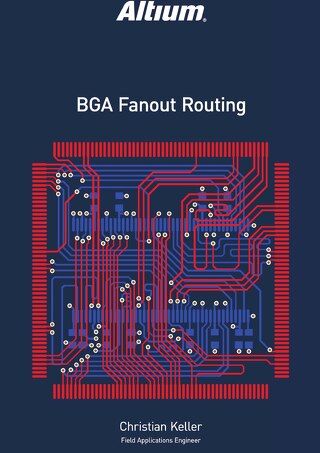Re-using Circuits with Snippets Shaves Design Time

Learn how to make reuse of circuits with snippets in Altium Designer to save time on your design process.
Often, a commonly used circuit, such as a power supply that has met UL or EMI certification, may appear in many designs. Or, a circuit such as an output buffer, might be reproduced several times on one PDB. The design can be accelerated by grabbing those circuit layouts and re-using them, both on a single board design in the case of the buffer, or on many designs, like the power supply example.
The Snippets feature of Altium Designer provides a quick and simple way to preserve and make reuse of design blocks in a circuit design. Saved Snippets can be added into any design without redesigning the circuit layout each time from scratch - design reuse, made simple.
USING SNIPPETS
The Snippets tool gives PCB designers several options for saving circuits for reuse. You can save any selection of:
- Circuitry on a single schematic sheet
- Circuitry in a PCB design, including the components and routing
- Code from within one of Altium Designer’s code-aware editors
Access the Snippets panel from the menu associated with the System panel-access button, situated under the main design window. Alternatively, you can access the panel through the View -> Workspace Panels -> System sub-menu.

Figure 1 - Snippets can be accessed from the System menu
SNIPPET ORGANIZATION
Using the circuits with snippets in PCD design with the panel organizes the snippets in folders, allowing you to group related circuits, sub-circuits, and design blocks together. There are two types of folders in the snippets system.
Snippets Folders - these are existing Windows® folders that can contain both snippets and one or more sub-folders of snippets. These top-level folders cannot be created from within the Snippets panel. Rather, they are ‘opened’ or ‘closed’ with respect to browsing the snippets they contain. These folders can only be created directly on your hard disk or network, outside of Altium Designer.
Sub-Folders - these are lower-level folders used to organize snippets in a more logical and structured way. They can be readily created (and deleted) from within the Snippets panel, or directly within an existing folder on your hard disk or network.
ADDING AND REMOVING SNIPPETS FOLDERS
Top-level Snippets folders are opened and closed from the Available Snippets Folders dialog. Access this dialog by clicking the Snippets Folders button (top-right of the Snippets panel) or by right-clicking within the panel and choosing Add -> Snippets Folder.
Use the Open Folder button to browse to the required folder on your hard disk or network. The selected folder will be added to the list in the dialog, and subsequently appear within the Snippets panel.

Figure 2 - Control which top-level folders of snippets are made available for use within Altium Designer
To remove a top-level snippets folder from the list, which is essentially closing it from a browsing perspective, select that folder in the list and click the Remove Folder button. Alternatively, right-click on the folder in the Snippets panel and choose Remove-> Close Snippets Folder.
Use the Move Up and Move Down buttons to change the order in which the top-level folders will be presented in the Snippets panel.
ADDING AND REMOVING SUB-FOLDERS
To add a new sub-folder in the overall snippets structure, right-click within the Snippets panel and choose the Add -> Create New Folder command. The Folder Properties dialog will appear, from where you can specify a name for the new folder and determine under which parent folder it is to be created.

Figure 3 - Assign names using the Folder Properties dialog
A sub-folder can be renamed and moved under a different ‘parent’ folder at any time by right-clicking on the folder in the Snippets panel and selecting the Properties command. The best way to delete a sub-folder is to right-click on its entry in the panel and choose Remove -> Delete Folder. The change is immediately updated on the Snippets panel. If you remove folders using Windows navigation, the change will not show up on the Snippets panel until Altium Designer is closed, then restarted.
CREATING SNIPPETS
To store a snippet in the Snippets panel, select the required circuitry on the schematic or Printed Circuit Board PCB editor, or code within a code-aware editor, then right-click and choose Snippets -> Create Snippet from a selected object’s command from the context menu. A Snippet can also be created from within the Snippets panel. With the objects/code selected in the editor, right click in the Snippets panel and choose the Create Snippet from Selection command.

Figure 4 - Example of creating a snippet from a schematic circuit fragment
Next, the Add New Snippet dialog will open. Use this dialog to define a name for the Snippet and to which folder it should be stored, as well as some descriptive comment which describes the circuitor code fragment.

Figure 5 - Define the properties of the new snippet as required
Once saved, the snippet will be created and subsequently presented in the Snippets panel. Note that the name, folder location and comment for a Snippet can be changed at any time from the Snippet Properties dialog – accessed by right-clicking on the Snippet entry in the panel and choosing Properties from the context menu.
Each Snippet is stored in a standard schematic, Printed Circuit Board PCB or code-based (e.g. *.vhd) file. Upon creation, several other files are also created (*.Snippet, *.SnippetIcon, *.SnippetThumbnail). An indexing file is also present for each snippet folder, to keep track of the snippets it contains.
PLACING SNIPPETS
To place a snippet in a design, select its entry in the Snippets panel and click the corresponding Place xxx button at the top of the panel. Alternatively, right-click on the entry for the snippet and choose Place Snippet from the context menu.

Figure 6 - The Place Snippet command will drop the circuit into the design
Make sure the correct target document is the open active document. Then, place a reusable design block, fragment of circuit, or code into your design from the Snippets panel. The command is only visible when the Snippet type matches the document type.
DELETING SNIPPETS
To delete a snippet, right-click on its entry in the Snippets panel and select the Delete Snippet command. To delete all snippets in a particular folder, right-click on that folder and choose the Remove -> Clear Folder command.
RIGHT-CLICK MENUS
Right clicking in the Snippets panel will offer the following options and commands:
- Place Snippet (available when a snippet is selected) - Place the currently selected snippet in the design workspace.
- Delete Snippet (available when a snippet is selected) - Delete the currently selected snippet.
- Add - Create a new folder under the parent folder, or add an existing Snippets folder to those available in the panel.
- Remove - Clear the contents of a folder, or delete the folder itself.
- Sort - Sort the panel’s folder/snippet listing by date/type/name and set the folder/details visibility.
- Show Thumbnails - Select Snippets to be displayed in thumbnail or icon form. In the icon state, a Snippet’s comment is not displayed in the panel.
- Properties - Opens the Snippet Properties dialog to view or edit the properties of the selected snippet.
CONCLUSION
Being able to make reuse of the Design Snippets feature of Altium Designer allows for the easy construction of a library full of commonly used circuitry that speed up your design process. This kind of automation is most effective for completing your designs by giving deadlines streamlining your design process saving you time and money.










